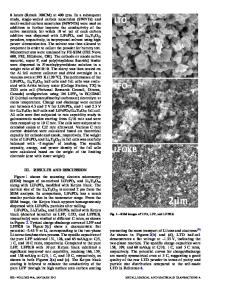Li 3 V 2 (PO 4 ) 3 modified LiFePO 4 /C cathode materials with improved high-rate and low-temperature properties
- PDF / 736,782 Bytes
- 6 Pages / 595.276 x 790.866 pts Page_size
- 75 Downloads / 308 Views
ORIGINAL PAPER
Li3V2(PO4)3 modified LiFePO4/C cathode materials with improved high-rate and low-temperature properties Zhipeng Ma & Guangjie Shao & Xu Wang & Jianjun Song & Guiling Wang
Received: 2 April 2013 / Revised: 13 May 2013 / Accepted: 22 June 2013 # Springer-Verlag Berlin Heidelberg 2013
Abstract LiFePO4/C surface modified with Li3V2(PO4)3 is prepared with a sol–gel combustion method. The structure and electrochemical behavior of the material are studied using a wide range of techniques such as X-ray diffraction (XRD), scanning electron microscope (SEM), transmission electron microscope, galvanostatic charge–discharge, and electrochemical impedance spectroscopy. It is found that LiFePO4/C surface modified with Li3V2(PO4)3 has the better electrochemical performance. The discharge capacity of the asprepared material can reach up to 153.1, 137.7, 113.6, and 93.3 mAh g−1 at 1, 2, 5, and 10 C, respectively. The capacitance of the LiFePO4/C modified by Li3V2(PO4)3 is higher under lower discharging rate at −20 °C, and the initial discharge capacity of 0.2 C is 131.4 mAh g−1. It is also demonstrated that the presence of Li3V2(PO4)3 in the sample can reduce the charge transfer resistance in the range of −20 to 25 °C, resulting in the enhanced electrochemical catalytic activity. Keywords Lithium iron phosphate . Lithium vanadium phosphate . High rate performance . Low temperature . Modification
Z. Ma : G. Shao : J. Song : G. Wang Hebei Key Laboratory of Applied Chemistry, College of Environmental and Chemical Engineering, Yanshan University, Qinhuangdao 066004, China Z. Ma : G. Shao (*) : J. Song : G. Wang State Key Laboratory of Metastable Materials Science and Technology, Yanshan University, Qinhuangdao 066004, China e-mail: [email protected] X. Wang The Equipment Research Institute of the General Logistic Department of the CPLA, Beijing 100010, China
Introduction Lithium iron phosphate, LiFePO4, is one of the most promising cathode electrode materials for next generation lithium-ion batteries. It possesses several advantages, including a high theoretical rate capacity of 170 mAh g−1, low cost, environmental compatibility, and intrinsic thermal stability [1, 2]. For pure LiFePO4, the inherent disadvantages of poor electrical conductivity (approximately 10−9 to 10−10 S cm−1) and slow diffusion coefficient of lithium-ion (approximately 10−14 to 10−16 cm2 s−1) have been demonstrated to be the predominant restriction to the high-rate and low-temperature performance of cell [3, 4]. Due to these unfavorable properties, many academic and industrial laboratories have devoted considerable effort to improving the electrode performance of LiFePO4 to a practical level [5–7]. Previous studies have tried to solve the conductivity problem. This goal has been achieved either by reducing the particle size or by coating the particle with thin layers of carbon or conductive polymer [8–12]. Recently, Scrosati et al. [13] reported a coprecipitation method combined with a solid-state method to synthesize double carbon-coated
Data Loading...










